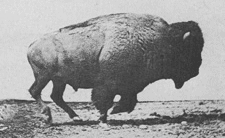
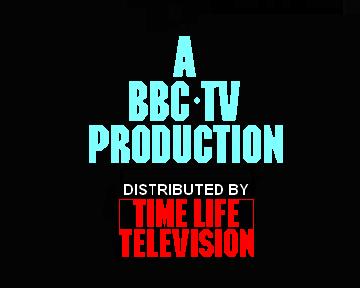
Click here to learn the story.
 |
 Click here to learn the story. |
|
Here are the program notes I wrote for a
35mm screening
in downtown Buffalo on Tuesday, 28 August 2001, as part of the
Buffalo Film Seminars.
I have since modified them in light of further research — both my own and others’.
|
The General |
|
Well, the moment you give me a locomotive and things like that to play with,
as a rule I find some way of getting laughs with it. Railroads are a great prop. You can do some awful wild things with railroads. |
|
BEFORE WE PROCEED,
please take a deep breath and make a deliberate decision to have some patience,
because before we open the curtain on Act One,
we shall assault you with a prélude consisting of a bunch of comparisons.
Without this prélude, nothing else will make sense.
When you buy a ticket to see The General at your local cinema, you have no idea what you’re in for.
You may see a lovely movie well presented, or you may see a repellent movie miserably presented.
When you buy a video of The General it is a good idea to make sure that it is really The General and not a counterfeit.
We’ll look at some images to illustrate what this means,
and then we shall watch a brief sequence as it appears in numerous different editions of the movie.
I think you will be not merely surprised, but downright shocked to discover how radically different they are.
This will help explain why your cousin in Tuscaloosa rented the movie and loved it
while your niece in Tallahassee rented the movie and hated it, even though they have the identical taste in movies.
As I have heard it said, with impatience,
“I don’t care what version it is! Just show me the movie, for crying out loud!”
On the left is the original. On the right is a public-domain copy:
  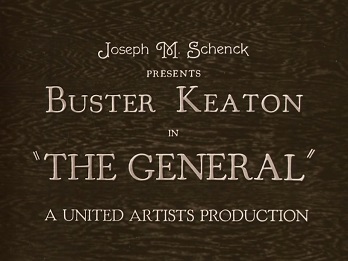 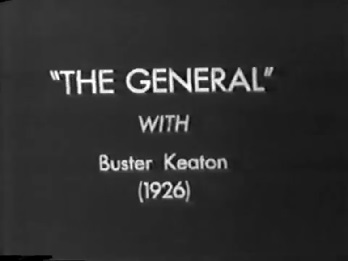 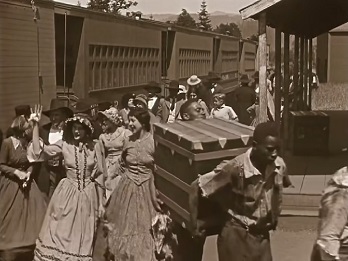  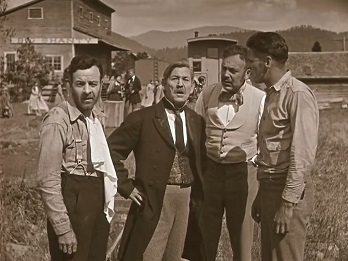 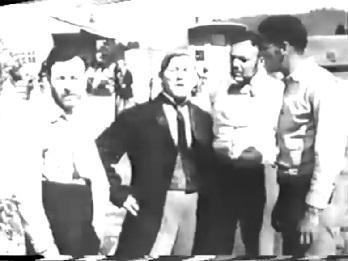 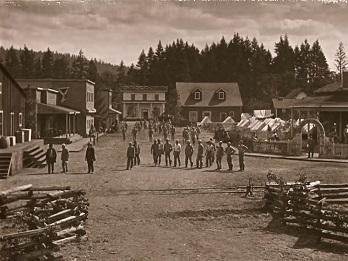 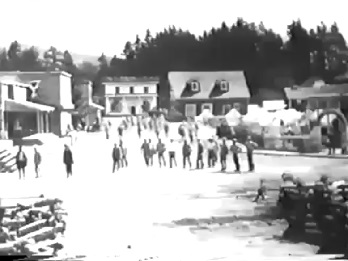
See? It makes a HUGE difference which version you watch.
Also, an inappropriate musical accompaniment will obliviate this movie and wreck your experience. Inappropriate musical accompaniments are terrifyingly common.
Some people love The General and some people hate The General, while others are indifferent.
Did they see the same film?
They probably all saw something called The General,
but they probably had no idea that they were not watching The General at all.
Let me make that clearer with examples.
Please click on each of the wood-chopping images below.
An epiphany is guaranteed.
Excellent edition, from a recent first-generation print, historically correct tints applied digitally, transferred at Buster’s preferred speed of 24fps, with sensitive musical accompaniment.
Thames premièred this on television on 7 October 1987,
but Kino greatly improved it for the 2009
Derived from MGM’s
Abridgment of the above abridgment, now with 52 minutes deleted,
narrated by Frank Gallop, included in a compilation film called The Great Chase,
which premièred on 4 June 1962.
Music by Larry Adler.
https://archive.org/details/the-great-chase_202108
The February 1962 German reissue reached the UK in September 1963.
It was printed from Rohauer’s 1960 dupe negative of the November 1926 preview print.
An inferior 16mm print served as the basis for the home videos, which were released without authorization –
on VHS in 1997 and on DVD in 2009.
The 16mm edition, and hence the videos derived from it,
brutally crops off the top, left, and right, allowing us to see only about half the image.
The revised US reissue by Jay Ward Productions,
derived from MGM’s
Mutilated July 1970 edition from Killiam Shows,
broadcast on 3 August 1971
for a TV series called “The Silent Years,”
with a piano score by William P. Perry.
Despite what the pundits would have you believe, Bill Perry wrote and rehearsed his score;
he most definitely did not improvise it.
This was later issued, in black and white, through Blackhawk.
https://youtu.be/dM6SKYnBuY8
Wretched 16mm bootleg of the July 1970 Killiam Shows edition, with 13 random 1930’s dance tunes that never fit.
(I think the music is all by Barnabás von Géczy, but I’m not sure.
This is remarkably similar to the track later used on the 1985
Crown Movie Classics VHS of Metropolis.)
Thunderbird issued this
defamation in 1972,
and I pulled this clip from the Pearl Entertainment VHS of 1991.
Unwatchable.
A disgrace, designed either by a madman or by saboteur who wanted to turn audiences against the film.
How could anybody enjoy this? That would be impossible.
Miserable 16mm bootleg of the Museum of Modern Art’s 16mm circulating print,
with Stuart Oderman’s piano score drowned out by Bob Lee’s cacophonous sound effects,
issued in 16mm on 5 July 1977 and on home video in 1984.
https://youtu.be/ro2tYM87pDM
Miserable 16mm bootleg of Ray Rohauer’s December 1972 touring edition, optically reduced and scored.
Rohauer derived this edition from the November 1926 preview print.
Reel Images first issued the 16mm edition in circa 1977/1978,
and this VHS edition came out in February 1978.
The film was slowed down to about 16fps by means of a prism.
I do not know who chose or added the canned music.
Guaranteed to put anyone off to the movie forever.
Six and a half years later, Video Yesteryear would reissue essentially this edition,
but with a new score by Rosa Río.
Derived from MGM’s
16mm bootleg of the Museum of Modern Art’s 35mm screening print,
with piano accompaniment by Jon Mirsalis, issued on VHS in 1981.
Here we go.
This is essentially the same as the February 1978 edition from Reel Images / Video Yesteryear,
from a 16mm bootleg from circa 1977/1978,
which was copied from Rohauer’s 18 December 1972 touring edition,
which in turn derived from his 1960 dupe negative of the November 1926 preview print.
Run in slow motion through a rotating-prism movement,
accompanied by Rosa Río on the Hammond organ,
issued on VHS and βeta on 31 October 1984.
Seems to be from William K. Everson’s 35mm dupe of the 35mm MoMA screening print.
Gaylord Carter accompanies on a theatre organ, no idea which organ or where.
Robert Harris’s RHD Films Dist. Inc. recorded this score in 1978
and David Shepard matched it to the film for the Kino VHS of 30 October 1989.
https://www.pbs.org/video/the-general-1926-nhixds and
https://youtu.be/2JHydgbK9lQ and
https://youtu.be/ksxYGC0-Mfs
This HAD to have been issued in about 1990 or 1991.
I assume this was from
an Italian VHS.
This is a bootleg of Blackhawk’s release of Killiam’s double-sprocket silent edition,
with library music and some sound effects added.
Unwatchable.
https://youtu.be/f4DsKbYD0aw
This Japanese laserdisc, “Best Selection Series,”
This is a 16mm print from
Film Classic Exchange, which
Charles Tarbox had founded in 1916.
It was definitely a
bootleg of the Museum of Modern Art’s 35mm screening print from 1936.
Tarbox asked his widow to sell his collection to Jeff Aikman,
who eight years later, in August 1992, founded Aikman Archives to issue the Film Classic Exchange movies on home video.
Aikman transferred The General in slow motion and added inappropriate music via needle drops.
He first issued this VHS in the UK sometime between August and December 1992.
Well-meaning, but not recommended.
On
Friday, 29 December 1995, WLVT Channel 39 in Allentown, Pennsylvania,
premièred Eric Grob’s new edition of The General,
which was merely Aikman’s edition but with Scott Joplin rag recordings on the soundtrack.
The tunes were not fitted to the action, but were just played one after the other.
Grob, of Pipersville, Pennsylvania, then offered a DVD of his new edition for $24.95.
Grob passed away and his company was dissolved.
In 2004, Elstree Hill Entertainment, a division of the Pickwick Group, Ltd.,
reissued Grob’s DVD edition, but with no credit to Grob or to Eye American or to Scott Joplin or to anyone or anything else, anywhere.
Pickwick claimed sole copyright to the film and soundtrack.
Unwatchable.
Licensed from David Shepard, who prepared the video transfer from the November 1926 preview print mixed in with an original release print.
Run at 26fps, which is a mite too fast.
The accompaniment is by Robert Israel, derived from photoplay mood music.
This laserdisc was issued on 1 June 1995
and the Kino K131 DVD was issued on 11 January 2000.
They are both now long out of print.
This edition was not bad (except that that a crucial moment is omitted), but, overall, I was disappointed.
Robert Israel later wrote a better score.
https://youtu.be/X-xMCuSL2rc
Licensed from David Shepard, who prepared the video transfer from the November 1926 preview print mixed in with an original release print.
Run at 26fps, which is a mite too fast, and the image is a bit stretched.
The accompaniment is by the Alloy Orchestra, and I have mixed feelings about the Alloy Orchestra.
Once in a while they invent a beautiful tune that fits perfectly.
Only once in a while.
The rest of their music irritates me so much that I have to eject the disc before I scream.
Ἁμαρτάνουσιν.
To say that they miss the mark is an understatement.
This disc was issued on 21 October 2003 and has long been out of print.
The Alloy Orchestra disbanded.
https://youtu.be/D8rJFXIwBWQ
Nice. This is certainly from a copy negative that Jay Ward Productions
had created for its 1970 reissue, but not the final copy negative.
I am now convinced that Jay Ward Productions ran off at least four copy negatives from the
Issued by subscription in a cardboard folder on Monday, 17 October 2005.
This is an uncredited copy of the Kino K131 DVD reissue of 1995’s “The Art of Buster Keaton,”
again with the beginning of Reel 7 missing.
The accompaniment is by a nonmusician who just kept hitting random notes.
Gloomy, isn’t it?
Highly recommended.
Licensed from David Shepard, who prepared a new, superior, video transfer from the November 1926 preview print mixed in with an original release print.
No deletions this time.
Some of the tint choices were a bit surprising, and I doubt they were authentic, but no matter.
Tints sometimes varied from one print batch to the next.
Run at 26fps, which is a mite too fast.
The accompaniment is by the Mont Alto Motion Picture Orchestra and it is splendid.
Rod Sauer chose typical cues used back in the day, and the result is lovely.
This disc was issued on 1 June 2006 and is available from
Mont Alto’s website.
This is truly one of the better video releases.
Copied from the Image Entertainment DVD (ID0559DSDVD) from 2003,
which in turn was derived partly from an original 1926 release print but mostly from the November 1926 preview print.
The noise on the soundtrack has nothing to do with the film.
This is from 2008 and is utterly disrespectful.
Copied from the Lobster edition.
A hobbyist stripped off Hisaichi’s music and edited in tunes by a band called Die Negerländer.
This is by no means official, and I doubt that Lobster or Die Negerländer are aware of this.
This is just a fan playing around, but this video has been on YouTube since 16 January 2009
and some people seem to enjoy it.
Nonetheless, this is inappropriate accompaniment;
it is imposing an unwanted interpretation,
distracting from the film rather than enhancing it.
https://youtu.be/coL-3VOJHNs
Copied and cropped from the Kino K669
Copied without attribution from “The Art of Buster Keaton,” Kino K131,
with a modern piano score by Stefano Bollani.
Issued by subscription by La Repubblica and L’Espresso on
Friday, 21 May 2010,
as part of its DVD series, “Sounds for Silence:
Capolavori del Cinema Muto e Musica d’Autore.”
Imposes an unintended mood that is contrary to the story.
I have no idea who issued this or when.
I have no idea what these musical recordings are.
I have no idea who edited them together.
What I do know is that this is an old 16mm print from Charles Tarbox’s Film Classic Exchange,
which, as we know, was duped from MoMA’s 35mm screening print.
This seems to be library music and it was definitely not on the film, but was added to the video file.
Someone named CopyLeftMovies uploaded it on 22 Sep 2011.
Other people downloaded it and posted it on their own channels:
JellyDonoughts on 12 May 2012,
Akimbofrenchfries on 27 March 2013,
demfeelsover9000 on 24 August 2013,
fauxToez on 23 June 2014,
Inter-Pathé on 10 April 2015,
Fracasao1 on Apr 17, 2018,
Hollywood Movies on 20 June 2018 (stretched image),
CMX Canada on 23 October 2018 (stretched image),
De todo un poco on 17 May 2019,
Retrography on 11 April 2020,
Nostalgia Lane on 14 March 2021,
Ayant Orcasitas on 12 August 2022,
Comedians on 18 November 2021, and
Classic Movie Time on 12 February 2023.
https://youtu.be/2BR15t-b-dM
Above is a preview for Mark Orton’s 90th-anniversary score, August 2016,
yet, inexplicably, this preview does not include any of his score;
it pulls from some other unidentified piece.
Now let’s hear a snippet:
The score is a 77-minute concert piece that has next to nothing to do with the movie.
It doesn’t play with the movie.
It doesn’t play against the movie.
It just plays away all on its own, without regard for the movie.
Apparently some people like it, though.
The print is from the Cottage Grove Historical Society,
and it is a dupe of Blackhawk’s 16mm release of Killiam’s 1970 edition,
with some of the gaps filled in with a dupe of Charles Tarbox’s dupe,
and with a few of Killiam’s editing mistakes corrected.
Unauthorized copy of the Lobster Films reconstruction,
digitally altered to run in slow motion,
with totally irrelevant vocal accompaniment performed at the Music Box Supper Club in Cleveland, 12 October 2016.
https://youtu.be/fLE9yyAY2oY
A live concert at the 2 Alexa club in St. Petersburg, 26 July 2017,
with the Kino K669
Derived from the Lobster Films edition, inauthentically tinted,
performed in 2019.
Hopeless.
Contradicts the story, opposes the film, protests the mood,
invites the audience to walk out in disgust.
When COVID-19 shut the Tampa Theatre down,
management invited Dr. Steven Ball to perform The General to an empty auditorium
but to a live-streaming virtual crowd at home.
Alas, what was projected onto the screen was a video file of an old Charles Tarbox print.
Derived from Aikman’s
|
|
Did you watch them all?
See? It’s the identical footage, but it’s a completely different movie each time.
Carl Davis (Kino K669) and William P. Perry (Killiam Shows)
played underneath the film; they supported the film.
The same holds true for Gaylord Carter (RHD Films), whose score,
though not exciting, is authentic,
exactly the type of accompaniment that most audiences would have heard in 1926 and 1927.
Joe Siracusa (Jay Ward Productions) employed standard cues of the year 1912,
and though that is not the most brilliant accompaniment,
it demonstrates yet again that the standard cues worked perfectly well.
Those scores, and other scores like them, can result in audiences roaring with laughter.
You will also run across other accompaniments that temper the film’s humor,
and which cause audiences to chuckle mildly now and then, but nothing more.
Then there are the other scores.
Firekid played over the film, in blatant disregard of the film, and drowned it out.
John Hiatt played in spite of the film,
with all the focus on his songs, while the film screened in the background for no particular reason.
Needle drops such as the Aikman edition are insults to the film and insults to our intelligence.
Jeff meant well; he really did. But good intentions do not necessarily good entertainment make.
Jeff Aikman founded his “JEF Films” in 1973
and launched his video label in the US sometime in the early 1980’s.
In England he introduced his “Aikman Archive” label in
August 1992
and his editions are, shall we say, disappointing.
The Silent Film Ensemble, which sports a most promising name, does not live up to its promise.
The foursome do not accompany the film, they reappropriate the film.
Then we get to things like
|
|
This is a misuse of the Lobster Films edition, this time rescored by François Narboni in March 2014.
When I pay $50 or $100 and attend a show such as this, I just walk out within one minute,
trying to calm myself down.
This is an offense, and I take offense.
What amazes me is that such composers are sincere and truly like the film,
though they obviously don’t understand it for beans,
and what amazes me even more is that their musicians don’t lynch them.
What offends me yet even more is that at the end of the performance,
the audience, as one, will rise to its feet and applaud and cheer and shout out “Bravo!”
as the entire orchestra takes bows and multiple curtain calls.
Audiences don’t do that because they like the show;
they do that because they know that they are expected to do that.
They won’t remember the show fifteen minutes later.
I long for the days when rotten tomatoes and hooks were considered appropriate responses.
I don’t belong in this modern world.
|
|
You can readily perceive that some of these presentations are works of outright vandalism,
designed partly as exhibitionism and partly to mock the film.
Actually, I think some of those responsible were just so bleeding dense
that they didn’t even realize they were insulting the film.
Their poor presentations and horrid accompaniments entirely ruin the movie,
drain of it every ounce of entertainment value, rip the soul out of it.
|
Video Tutorials |
|
I could go on griping and screaming my head off in rage for the next 500 hours, but what good would that do?
How about offering a solution?
Fortunately, Rod Sauer, for whom I have only infinite admiration, has offered a solution,
which he published through the
American Music Research Center
at the University of Colorado Boulder’s College of Music.
Click on each image to view the video.
|
|
It is possible to improvise or compose your own score,
but never never never never never be anachronistic,
and never never never never never distract from the film.
If you are an accompanist, your job is to support the movie,
not to be cute,
not to use the movie as a showcase
to publicize your rock band,
not to drown the movie out.
The movie is the star of the show.
The musicians are the supporting cast.
SUPPORT the film, do not CRUSH it,
do not draw attention to yourself.
DO NOT SHOW OFF!!!!!
When the musicians hog the stage, the performance is rendered worthless or less than worthless.
DON’T REINVENT THE WHEEL.
The work was done for you a century ago.
Use what was done. Do not dismiss it out of hand.
The filmmakers expected the musicians to behave, to follow standard procedure.
Do not deviate from that. Ever.
|
|
Most of you will like the Thames edition.
After all, Carl Davis’s score rules.
The Perry score is also agreeable though much of the film was terribly mutilated.
Jay Ward’s edition is also quite watchable,
though the
|
|
BUYER BEWARE!
As you learned above, if you had the patience to watch each of those clips,
what you see on a typical video of The General is not The General; it is a forgery.
Before we proceed, here are seven commonly available discs:
|
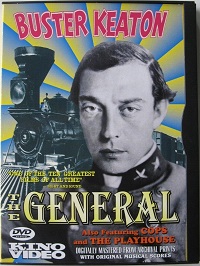
Kino K131 DVD from 1999.
Telecined in part from an original 1926 tinted release print, in part from the preview print,
and possibly from other sources as well.
The beginning of Reel 7 is missing.
Looks not too bad on modern equipment, but on the old CRT sets, this looked worse than VHS quality.
The print was not cleaned.
Retains the copyright credit.
Run at 26fps, which is too fast.
Musical score by Robert Israel.
Region 1 NTSC, which will not display on European equipment.
|

Image ID0559DSDVD DVD from 2003.
Scanned from the same print used in Kino K131, but with the beginning of Reel 7 restored.
A much better digital transfer.
Retains the copyright credit.
Run at 26fps, which is too fast.
Music score by the Alloy Orchestra, which maybe some people like, but I sure don’t.
I can’t even watch this thing because the music wrecks the movie for me.
Region 0 NTSC, which may or may not display on European equipment.
|
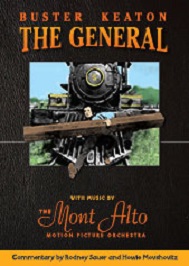
Once again, David Shephard was responsible for this digital transfer,
and, once again, it’s too fast.
This may or may not be from the same print as the previous two DVD’s.
I would need to check moment by moment, and maybe I’ll do that someday.
The beginning of Reel 7 is restored.
The copyright credit is deleted and replaced with the music credit.
The tinting does not match that of the original print in Kino K131.
The Mont Alto ensemble’s musical selections are really nice, and optional subtitles identify each piece.
Among the extras is Rod Sauer’s presentation on “Silent film music and James Bradford’s cue sheet for The General,”
and for that alone this DVD is a |
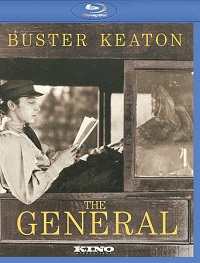
THIS IS THE BEST ONE. SEARCH FOR THIS ONE.
Kino K669
THIS IS THE ONE TO WATCH. SELECT THE CARL DAVIS SCORE. |

Kino 21162 Blu-ray from 2018.
This should have been gorgeous,
as it was taken from a copy negative made from a |
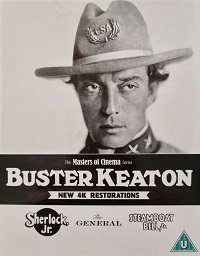
Eureka “Masters of Cinema” EKA70629 B Blu-ray from 2017.
Seems to have been scanned from the original camera negative.
Digitally cleaned, resulting in the clearest image yet.
Deletes the copyright credit,
and there is no tinting; those are this disc’s only drawbacks.
The images throughout are stabilized, much steadier than the original prints.
Run at 24fps, which was Buster’s preference.
Retains Carl Davis’s half-minute musical overture.
Region B, which will not display on US equipment.
|
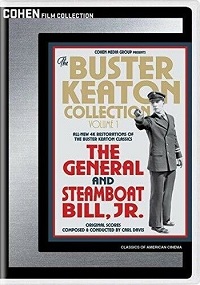
Cohen Media Group CMG-BD-8523 Blu-ray from 2019.
Essentially identical to the Eureka edition.
Again, no tinting.
The deletion of the copyright credit and the failure to reproduce the original tinting are the only defects.
Since it is not tinted, I would much rather recommend Kino K669.
Retains Carl Davis’s half-minute musical overture.
Region A, which will not display on European equipment.
|
|
https://youtu.be/Za6-PbKNdfk, posted 23 January 2014. When YouTube disappears this video, download it. |
DON’T BELIEVE THE LIES
Pretty much everything you have heard and read about this movie is wrong.
Beginning in the late 1970’s,
scholars and fans agreed upon a dogma, a set of core beliefs.
Each one of these articles of faith is provably false.
Here is the creed:
• The film flopped. Actually, it was a success and turned a healthy profit.
• The film was badly reviewed. Actually, most of the reviews ranged from favorable to enthusiastic. • The financial failure of the film ended Buster Keaton’s artistic freedom. Actually, it was a series of business decisions by United Artists and a board of trustees that closed its production unit and transferred Buster to a different position, where he would be a contract actor on other people’s movies. Under the new contract, he was no longer permitted to create his own stories or to select appropriate material. That series of business decisions started when The General began shooting. The full story is much more complicated, as you will learn below. • The wrecked locomotive is still a tourist attraction in Oregon. Actually, it was scrapped during WWII. • The film went wildly overbudget. Actually, it was completed within its original budget, about $415,000 negative cost plus an extra $85,000 for total production cost. • The locomotives caused raging forest fires that increased the budget astronomically. Actually, the few small fires that the locomotives caused were snuffed out immediately. The fire that shut down location work for a month was entirely unrelated. • Buster risked his life and the lives of his fellow performers by his insistence upon realism. There were a few careless accidents, mostly caused by some extras who didn’t follow instructions, but there were safety precautions in use at all times.
Disappointed?
The truth proves itself to be a lot more fun than these facile fibs, as you will soon see.
|
|
A United Artists Presentation
Written and Directed by Buster Keaton and Clyde Bruckman Additional Material [i.e., a few of the title cards] by Al Boasberg and Charles Henry Smith |
| Produced by | Joseph M. Schenck (25 Dec 1876 – 22 Oct 1961) |
| Directors of Photography | J. Devereaux “Dev” Jennings (22 Sep 1884 – 12 Mar 1952) and Bert “Boots” Haines (14 Dec 1896 – 19 Jun 1991) |
| Camera Operators |
Elmer Ellsworth (14 Jan 1900 – 04 Apr 1969) and Byron Houck (28 Aug 1891 – 17 Jun 1969) |
| Assistant Camera Operator | Harry J. Wild (05 Jul 1901 – 25 Feb 1961) |
| Scenic Director | Harry “Rosie” Roselotte (04 May 1885 – 26 Jun 1935) |
| Production Coördinator | Harry Brand (20 Oct 1895 – 22 Feb 1989) |
| Assistant Production Coördinator | John W. Considine, Jr. (07 Oct 1898 – 22 Mar 1961) |
| Location Manager/Chief Property Man | Bert E. Jackson (06 Sep 1889 – 16 Feb 1964) |
| Properties Crew | Mike Graves (29 Mar 1902 – 08 Apr 1987) and others |
| Assistant Director | Edward Hearn (06 Sep 1888 – 15 Apr 1963) |
| Casting Director | Harry Wallace Manny Barnes (09 Jan 1899 – 21 Jan 1975) |
| Chief Draughtsman | Billy Wood (24 Mar 1904 – 30 Jul 1986) |
| Bridge Timber Contractor | George E. Potter |
| Bridge Timber Crew | William Ernshaw (14 Apr 1900 – 30 Oct 1992) and others |
| Brakemen | Fred Alton Lowry (23 Mar 1904 – 16 Jan 1967) and others |
| Production Manager/Technical Director | Fred Gabourie (19 Sep 1879 – 01 Mar 1951) |
| Technical Director for Battle Scenes | Glen W. Cavender (19 Sep 1883 – 09 Feb 1962) |
| Chief Makeup and Wardrobe | John K. Pitcairn (1888 – ????) |
| Assistant Makeup and Wardrobe | Bennie Hubbel and Fred Carlton Ryle (05 Jan 1899 – 03 Mar 1960)(Western Costume Company) |
| Lighting Effects | Denver Harmon (03 Oct 1892 – 01 Feb 1959) |
| Construction Foreman | Frank Barnes (31 Jul 1898 – 20 Jul 1973) |
| Construction Crew | Jack Coyle (05 Nov 1890 – 30 May 1970) and others |
| Bridge and Dam Construction | H. L. Jennings |
| Chief Mechanic and Firefighter | Fred Wright (08 Mar 1865 – 12 Dec 1928) |
| Munitions Foreman | Jack Little (11 Aug 1894 – 26 Jul 1968) |
| Chief Electrician | Ed Levy (15 Apr 1893 – 23 Jul 1974) |
| Still Photographers | Byron Houck (28 Aug 1891 – 17 Jun 1969), Dal Clawson (04 Oct 1885 – 18 Jul 1937), and William Piltz (07 Jun 1875 – 02 Nov 1944) |
| Publicity Photographer | Melbourne Spurr (22 Dec 1888 – 03 Oct 1964) |
| Horses and Mules Supplied by | Dee Wright, Eugene, Oregon (14 Mar 1872 – 24 Apr 1934) |
| Railroad Assistance | L.L. Graham and Bob Holmes, Oregon Pacific and Eastern Railway |
| First Aid | Dr. Axley and Dr. Frost, Cottage Grove, Oregon |
| Buster Keaton’s Valet and Chef | Willie [William Melvin] Riddle (01 Dec 1887 – 19 Jun 1964) |
| Buster Keaton’s Cook | Viola May Riddle (née Copeland, 29 Apr 1892 – 10 Mar 1992) |
| Catering | Anderson & Middleton, under the direction of George E. Potter |
| Chef | Ralph Land |
| Continuity | Chrystine Francis [Malstrom] (27 Mar 1903 – 12 Feb 1952) |
| Production Secretary | Betty B. Cavender [née Walsingham] (25 Nov 1899 – 16 Sep 1941) |
| Production Supervisor / Production Accountant | Lou Anger (12 Feb 1878 – 21 May 1946) |
| Production Accountant (Oregon) | Wesley G. Gilmour |
| Location Screening Facility | Arcade Theatre, Cottage Grove, Oregon |
| Editor | Buster Keaton (04 Oct 1895 – 01 Feb 1966) |
| Assistant Editors | John Sherman Kell (18 May 1884 – 18 May 1951) and Harry Wallace Manny Barnes (09 Jan 1899 – 21 Jan 1975) |
| Music Compiled by | James Charles Bradford (13 Jun 1885 – 11 May 1941) |
| Published by | Cameo Music Service Corporation, NYC (1914 – 1929) |
| CAST | |
| Johnnie Gray | Buster Keaton (04 Oct 1895 – 01 Feb 1966) |
| Annabelle Lee | Marion Mack (08 Apr 1902 – 01 May 1989) |
| Her Father | Charles Henry Smith (12 Jul 1866 – 11 Jul 1942) |
| Her Brother | Frank Barnes (31 Jul 1898 – 20 Jul 1973; IMDb is wrong) |
| Captain Anderson | Glen W. Cavender (19 Sep 1883 – 09 Feb 1962) |
| General Thatcher | Jim Farley (08 Jan 1882 – 12 Oct 1947) |
| A Southern General | Frederick Vroom (11 Nov 1857 – 24 Jun 1942) |
| A Union General | Joe Keaton (06 Jul 1867 – 13 Jan 1946) |
| A Union General | Mike Donlin (30 May 1878 – 24 Sep 1933) |
| A Union General | Tom Nawn (11 Jan 1863 – 08 Feb 1949) |
| Boy (freckled, with hat) | Jackie Hanlon (15 Feb 1916 – 13 Dec 2012) |
| Boy (with long hair) | Jackie Lowe (01 Feb 1921 – 10 Nov 1978) [IMDb is wrong] |
| Recruiter | Frank Sidney Hagney (20 Mar 1884 – 25 Jun 1973) |
| Raider (Union corporal, 6'7") | Jack Dempster (1901 – ????) |
| Raider | Budd Nathan Fine (10 Sep 1894 – 09 Feb 1966) |
| Raider | Ray Hanford (16 Sep 1887 – May 1939) |
| Raider | Al Hanson (or Al Handon?) |
| Raider | Anthony Harvey (Anthony Joseph VaConti, aka Toney Harvy, 1374 Van Ness Ave, 1 July 1903 – ????) |
| Raider | Ross McCutcheon (20 Jun 1901 – 19 Apr 1984) |
| Raider | Tom Moran |
| Raider | Earl Mohan (12 Nov 1889 – 15 Oct 1928; also stunted for Tom Moran) |
| Raider | Charles Phillips (30 Oct 1903 – 25 May 1958) |
| Raider | Red Rial |
| Raider | Ray Thomas |
| Raider | Red Thompson (15 Jul 1889 – 29 Jun 1927) |
| Columbia Engineer | Jimmie (Jimmy/Jimyi?) Bryant??? |
| Columbia Fireman | Ed Foster |
| A Union Officer | Edward Hearn (06 Sep 1888 – 15 Apr 1863) |
| Raider who captures Annabelle | Louis Lewyn (18 Dec 1891 – 24 May 1969) |
| Union and Confederate Soldiers | Oregon State Guard, about 500, under the command of Captain Charles W. Evans, Captain J. Wray Chase, Captain C.C. Cruson, and Sergeant Henry Charles Bukowski; also some locals: Henry Baird, Joe Bricher, Kieth Fennell, Ronald Gilstrap, “Fat” Kerr, Billy Lynn, James Walsh, John Wilson, Harold Terry, and others; and 80 students from O.A.C. (Oregon Agricultural College) |
| Also in the cast and crew |
Charles
Gilmore Suzanne King Grace Jones Fred West Gene Woodward (1910 – 1993) Joseph Anderson Wisdom (unused scene) (08 Apr 1848 – 29 Nov 1937) Ned Binford (unused scene) (28 Nov 1850 – 16 Mar 1936) the Patton family Bill Landers Snitz Edwards (unused scene) (01 Jan 1868 – 01 May 1937) Delbert Samuel Springsteen (13 Dec 1896 – 27 Jan 1974; was he Johnnie’s fireman?) Samuel Glenn Stevens (23 Apr 1880 – 21 Apr 1950) and many others |
|
Niles Essanay Silent Film Museum, Buster Keaton’s Early Years with Martha Jett, posted on Apr 4, 2020. When YouTube disappears this video, download it. |